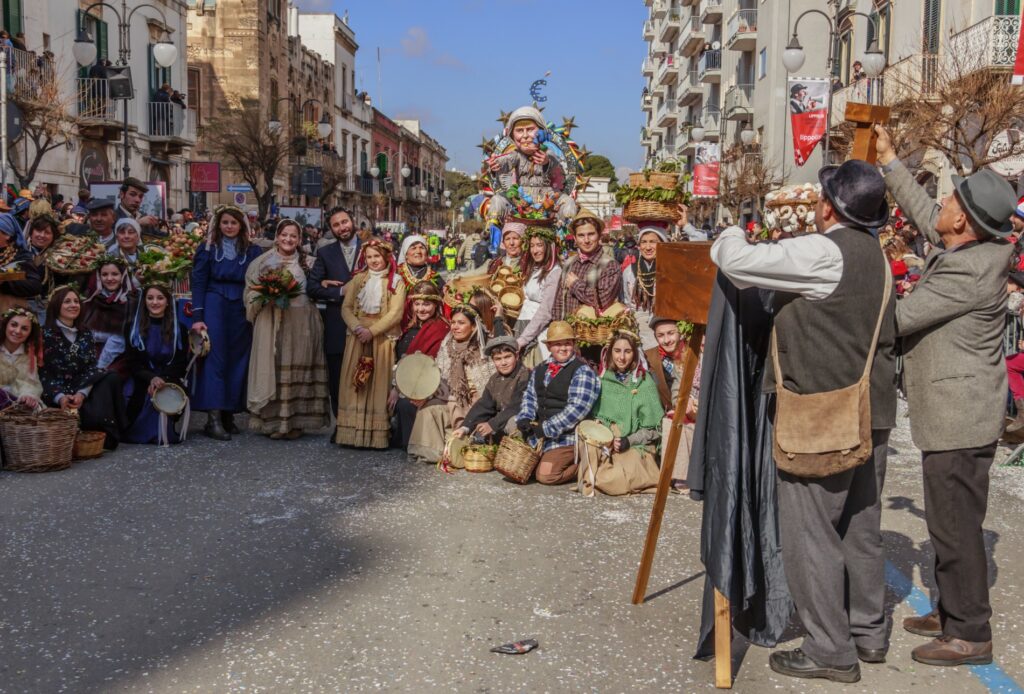Venezia and Viareggio are the most famous, but there are other historically significant Carnevali around Italy, Putignano, Cento, and Fano being, perhaps, the names we are more familiar with. We are talking about events with a long history and that, through time, managed to develop a deep and meaningful connection with the territory, often becoming its symbol.
In 2022, in a significant move towards cultural preservation and international recognition, some of our most notable historic carnivals – those of Avola, Acireale, Cento, Foiano, San Giovanni in Persiceto, Sciacca, Putignano, Tempio Pausania, and Fano – united in their quest for UNESCO Intangible Cultural Heritage status. It was an important move, born from the desire to highlight their unique cultural and traditional significance, at national and international levels.
The initiative was led by the Carnival of Fano, one of Italy’s oldest, and it was the city’s Mayor, Massimo Seri, who perhaps explained best the importance of Carnevali for the community, when he said that they “bring joy and unity, especially following challenging times,” also noting the “intrinsic cultural identity each festival carries.”
UNESCO’s decision about the candidature should take place soon: it’s time, then, to take a closer look at these eleven magical Carnevali, while keeping our fingers crossed for them, of course.
Carnevale di Acireale (Sicily)
The Acireale Carnival is known for its magnificent baroque-style floats adorned with flowers, making it one of Italy’s most beautiful carnivals. Originating in the 16th century, this event transitions from citrus-throwing festivities to a grand parade of allegorical and grotesque papier-mâché floats, often based on satirical themes and characterized, as is often the case, by their incredible beauty and the artistry of local float builders
Carnevale di Avola (Sicily)
While not as known as others in this list, the Carnival of Avola impresses for its blend of traditional festivities and local folklore. Avola’s carnival is characterized by its colorful street parades, traditional costumes, and the involvement of the whole community in celebrating the end of winter and the anticipation of spring. This aspect connects it directly to the ancient celebrations of our Roman ancestors, which used to take place in the same period of the year.
Carnevale di Cento (Emilia-Romagna)
Twinned with Rio’s Carnival, Cento’s celebrations are a spectacle of color, music, and creativity. Known for its elaborate floats and the burning of the Tasi mask, this event draws on a long history and tradition: its celebration was already depicted in the frescoes of Giovanni Francesco Barbieri, known as Guercino, a baroque painter born in Cento in 1591, and active as an artist especially in Bologna and Rome
Carnevale di Fano (Marche)
The Carnival of Fano is considered the oldest in Italy, predating even the Carnival of Venice. It offers a unique blend of historical tradition and community celebration, and it is particularly famous for its getto dei dolciumi – the throwing of sweets and chocolates to the crowd from floats.
Carnevale di Foiano (Tuscany)
Dating back to the 16th century, Foiano’s carnival is among the oldest in Italy and it is renowned for its large papier-mâché floats and the symbolic burning of the King of the Carnival, a moment symbolizing the spirit of satire, renewal, and community that pervades this historic celebration.
Carnevale di Mamoiada (Sardinia)
This unique carnival stands out for its traditional masks, the Mamuthones and Issohadores, which are associated with ancient rites of fertility and nature. The mysterious, somber Mamuthones, clad in black sheepskins, contrast with the colorful Issohadores and offer us a glimpse into Sardinia’s rich cultural heritage and the community’s deep connection to its past.
Carnevale di Melilli (Sicily
A cherished event in the Hyblean territory, this Carnevale is known, as many of the other Carnevali in this list, for its allegorical floats and masked groups. The first Carnevale in Melilli was celebrated in 1936 when the “a Someggiata” group created a special float called “Vivere – Non si Muore Mai,” a sentence that well embodies the joy de vivre we often associate with Carnevale celebrations everywhere. The carnival is a time when the community, wearing costumes and masks, partakes in impromptu skits, reflecting a deep-rooted tradition that continues to thrive today.
Carnevale di Putignano (Apulia)
Recognized as one of Europe’s longest carnival celebrations, Putignano’s festivities begin on December 26, leading up to Lent. Its history, which dates back to 1394, is celebrated with elaborate floats, masks, and a mix of satire and tradition, highlighting the community’s creativity and the carnival’s deep-rooted significance.

Carnevale di San Giovanni in Persiceto (Emilia-Romagna)
This carnival is famous for its unique “Spilli” tradition, where floats reveal surprising transformations, engaging the audience with satirical representations of current events and personalities. Its blend of humor, artistry, and community involvement makes it a distinctive celebration within Italy’s carnival landscape.
Carnevale di Sciacca (Sicily)
Sciacca’s Carnival is one of Sicily’s most vibrant, with its detailed floats, traditional costumes, and lively atmosphere. The event peaks with the crowning of the King of the Carnival, a
representation of the town’s spirit and enthusiasm. Sciacca’s festivities are a highlight of Sicilian culture, that combine creativity, tradition, and communal joy.
Carnevale di Tempio Pausania (Sardinia)
In the heart of Sardinia, Tempio Pausania’s carnival is celebrated with traditional masks, folk dances, and a strong sense of community. The event is known for its unique masks, such as the Giants, representing historical figures, and the Merdules, an amazing example of local craftsmanship and cultural identity.
The pursuit of UNESCO Intangible Cultural Heritage status is a natural progression for these historical carnivals, which aim to see their role in contributing to the identity and cultural richness of their regions recognized. Indeed, such recognition would not only validate their cultural and historical significance but also ensure their preservation and safeguarding in the years to come. As these communities await the decision, their unified effort is yet another sign of the strong connection between them and their history and traditions, and of the importance of cultural identity and heritage.





























